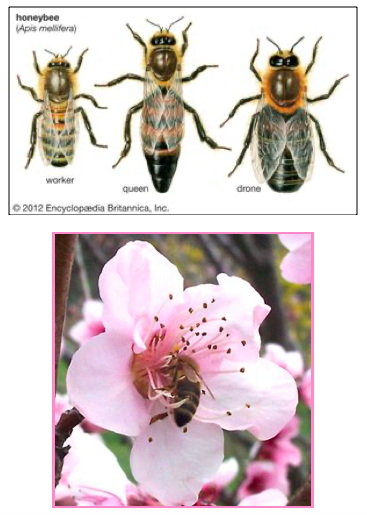Hello Honey! NEWSLETTER April 2023
Hello Honey! NEWSLETTER April 2023
Hello Honey! NEWSLETTER April 2023
Hello Honey! NEWSLETTER April 2023
Hello Honey! NEWSLETTER April 2023
Hello Honey! NEWSLETTER April 2023
Hello Honey! NEWSLETTER April 2023
Hello Honey!
NEWSLETTER
_____________________________________________
April 2023
Good Morning from Vietnam!
Royal Viet Thanh wishes you …
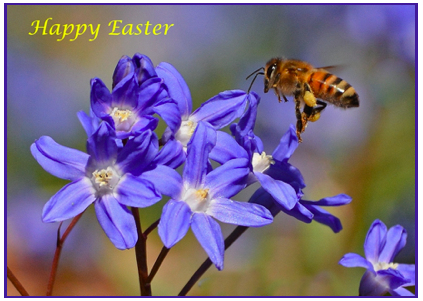
With our Wonderful Honey from the Mountains of Vietnam
We have to thank our Laborers, the Busy Bees this year for an enormous wealthy
harvest of Honey of all sorts. What could be harvested already is overwhelming …

And please remember this:
That’s the most astonishing fact about Bees I ever came across
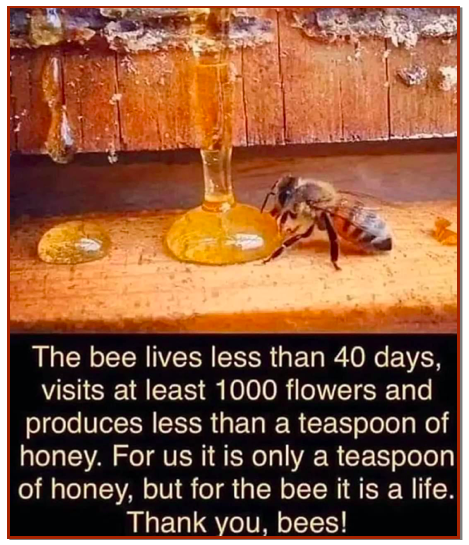
Now you might be astonished like I was and get to fall in Love with the
best Worker you ever head building your business indeed with her life.
So we have some thing nice for you to read over Easter Holidays …

Fantastic Facts about the
____________________________________
Honey-Bee
Honeybee, (tribe Apini), also spelled honey bee, any of a group of insects in the family Apidae (order Hymenoptera) that in a broad sense includes all bees that make honey. In a stricter sense, honeybee applies to any one of seven members of the genusApis—and usually only the single species, Apis mellifera, the domestic honeybee. This species is also called the European honeybee or the western honeybee.
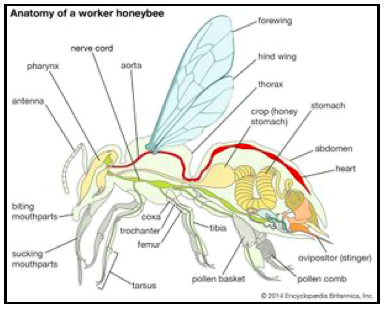
All honeybees are social insects and live together in nests or hives. The honeybee is remarkable for the dancing movements it performs in the hive to communicate information to its fellow bees about the location, distance, size, and quality of a particular food source in the surrounding area.
The following sections provide an overview of the different honeybee species, honeybee biology, and diseases of honeybees. For more detailed information on honeybees, their colonies, and diseases, see the articles beekeeping and colony collapse disorder.
Apis Species
With the exception of A. mellifera, all other Apis species are confined to parts of southern or southeastern Asia. A. florea, the dwarf honeybee, occurs in southern Asia, where it builds its nests in trees and shrubs. A. andreniformis, the black dwarf honeybee, is native to forested habitats of southeastern Asia.
A. dorsata, the giant honeybee, also occurs in southeastern Asia and sometimes builds combs nearly three metres (more than nine feet) in diameter. A. cerana, the Eastern honeybee, is native to southern and southeastern Asia, where it has become domesticated in some areas.
It is very closely related to A. koschevnikovi, or Koschevnikov’s bee, which is found only on Borneo and several other islands in Southeast Asia and on the Malay Peninsula. A. nigrocincta is native to Indonesia and Mindanao island in the Philippines. There are also a number of subspecies and strains of Apis.
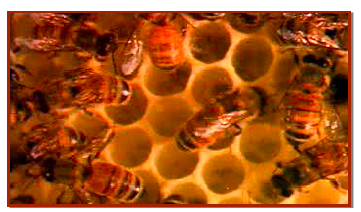
A. mellifera is about 1.2 cm (about 0.5 inch) long, although size varies among the several strains of this species. The head and thorax, or midsection, are somewhat bristly and vary in color according to the strain. Two large compound eyes and three simple eyes, or ocelli, are located on top of the head. Keen eyesight is complemented by two sensitive odor-detecting antennae.
Honeybee Sexes and Castes
There are two honeybee sexes, male and female, and two female castes. The two female castes are known as workers, which are females that do not attain sexual maturity, and queens, females that are larger than the workers.
The males, or drones, are larger than the workers and are present only in early summer. The workers and queens have stingers, whereas the drones are sting less.
Queen honeybees store sperm in a structure known as the sperm theca, which allows them to control the fertilization of their eggs. Thus queens can lay eggs that are either unfertilized or fertilized. Unfertilized eggs develop into drones, whereas fertilized eggs develop into females, which may be either workers or virgin queens.
Eggs destined to become queens are deposited in queen cells, which are vertical cells in the honeycomb that are larger than normal. After hatching, the virgin queens are fed royal jelly, a substance produced by the salivary glands of the workers.
When not fed a diet consisting solely of royal jelly, virgin queens will develop into workers. During the swarming season, in the presence of a weak queen or in the absence of a queen, workers may lay unfertilized eggs, which give rise to drones.
Life Cycle
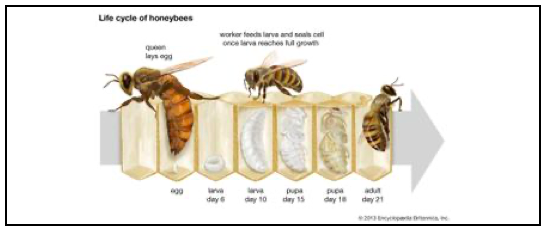
For all three forms of honeybees, eggs hatch in three days and then develop into larvae that are known as grubs. All grubs are fed royal jelly at first, but only the future queens are continued on the diet. When fully grown, the grubs transform into pupae. Queens emerge in 16 days, workers in about 21 days (on average), and drones in 24 days. After emerging, the queens fight among themselves until only one remains in the hive. The old queen and the majority of her workers typically have left the hive by the time the new queens emerge. The swarm, which typically reproduces during swarming, may form two or more new colonies at different nesting sites.
Polyandry
A queen will often mate with many drones, a mating behavior known as polyandry. Polyandry increases genetic diversity within a colony and thereby improves colony fitness and survival. Genetically diverse colonies have characteristics—such as increased population size, foraging activity, and food supplies—that favor the production of new queens and the formation of new colonies.
Hives
The hive is a series of combs composed of two layers of six-sided cells made of wax produced and secreted by the workers. Food in the form of honey, plant nectar, and so-called bee bread, made from pollen, is stored in the cells.

Honey, which the bees produce from the nectar of flowers, was virtually the only form of sugar readily available to humans until modern times. For this reason, honeybees have been domesticated by humans for centuries. The art of caring for and managing colonies of honeybees is known as beekeeping. Besides producing honey, honeybees play an important role in agriculture as pollinators of a wide variety of domesticated plants.
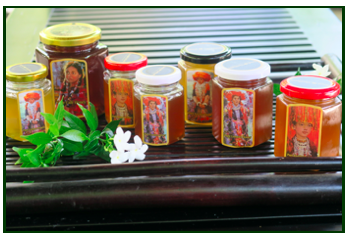
Brought to you from
VIET THANH
HONEY EXPERTS
Contact:
Mr. Trung Thanh Vu
Founder and Co-Owner
Headquarter: 59 Truong Son Str, Tan Binh Ho Chi Minh City, Vietnam.
Factory: 153 Ho van Tang Str, Tan Phu Trung ,Cu Chi District, Chi Minh City, Vietnam.
Direction Calling: +84-88 834 3333
Viber/WhatsApp: +84.888 34 3333.
Email: trungvu.vietthanhfood@gmail.com,
Website: www.vietthanhgroup.com.vn
More posts
Hello Honey! NEWSLETTER Anuga - 26/10/2023
Hello Honey! NEWSLETTER August 2023 - 18/08/2023
Hello Honey! NEWSLETTER July 2023 - 18/08/2023
Hello Honey! NEWSLETTER June 2023 - 18/08/2023
Hello Honey! NEWSLETTER May 2022 - 18/08/2023
Hello Honey! NEWSLETTER February 2023 - 18/08/2023
Hello Honey! NEWSLETTER February/ March 2023 - 18/08/2023
Hello Honey! NEWSLETTER January 2023 - 18/08/2023






